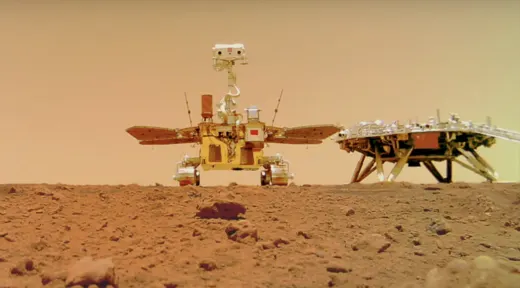
A little less than a year ago, China’s Zhurong rover entered hibernation. It was supposed to be a brief sleeping period, but recent images by a NASA orbiter reveal that the Martian rover is still napping. The pictures, taken by NASA’s Mars Reconnaissance Orbiter‘s High Resolution Imaging Science Experiment (HiRISE) camera, show side-by-side photos captured on March 11, 2022, September 8, 2022 and February 7, 2023.
Due to the harsh conditions of the Martian winter, Zhurong was programmed to go into hibernation until the beginning of the Martian spring in late December. Heavy sand and dust storms characterize Martian winters, making it hard for solar-powered rovers, blocking their solar panels and rendering them powerless. To combat this, space agencies will power down the rovers to conserve energy. Once the sandy season has passed, the rovers will reboot and continue their journeys.
Unfortunately, for some, such as the now-defunct InSight, if too much dust accumulates on the solar panels, the robot can become inoperable (a radioisotope power system enables NASA’s Curiosity and Perseverance rovers to survive these harsh winters).
Dust accumulation could have also affected Zhurong’s two “windows” that let a substance called n-undecane store heat energy during the day and release it at night. Whatever the reason, China has remained mum on the issue.
A source told the South China Morning Post in January that the rover had gone silent after going into hibernation, but the China National Space Administration (CNSA) has remained silent, continuing a pattern of secrecy surrounding its missions.

On February 10, Chinese state media commemorated the two-year anniversary of the Mars mission. The Tianwen-1 orbiter, which relays data between the rover and ground control, is in good shape, according to Xinhua, China’s news agency, and will keep performing various tasks related to the Red Planet. The post did not mention Zhurong’s present state, though.
Tianwen-1, China’s first interplanetary mission, sat Zhurong on Mars on May 14, 2021. The rover’s initial exploration timeframe was 90 days. Therefore, even if Zhurong doesn’t awaken from its protracted Martian nap, it will still have made history.






